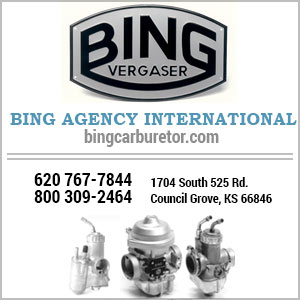Honing or deglazing?
After the pistons have been removed from the cylinders for inspection of end gap and side clearance of the rings along with the cylinder bore for wear, should the cylinder walls be deglazed if the rings are to be reinstalled?
Thoughts...
• Although there's a technical difference, most people in a motorcycle shop will use those 2 terms (hone and deglaze) interchangeably.
• You always want to work with the true, finished diameter of the cylinder. Therefore the FIRST step is to deglaze the cylinder wall. THEN, end gaps can be set and piston clearances can be measured.
• Deglazing should be done in warm water mixed with a strong detergent, like Dawn. This will lift the abrasive out of the cylinder wall. Thinners, like kerosene and parts washing liquid, don't have that capability.
• The better deglazing hones will be a very fine grit. There's a lot of research showing engines last longer using the finer grit.
• You MUST deglaze when you install new rings.
• When you assemble the engine, wipe the cylinder wall with a rag that saw clean oil last week. You want barely enough oil to keep the cyl wall from rusting. Same for the rings. Use the very MINIMUM of oil and your results will be much better. (If this makes you afraid, then turn the engine over with the starter to get the oil pressure up before starting.)
► I prefer the "Diggle berry" type hones with the hundreds of little balls, turned by a variable speed drill. To get a good cross-hatch the hone can't be turned at high speeds. Variable speed will allow you to slow things down. We had an old dish washer for cleaning abrasives out of engine parts. We simply put the parts in there and ran a mini-cycle with detergent. Things really need to be clean and free of abrasive.
Hope this helps.
Owning an old Airhead is easy.
Keeping an old Airhead running great is the true test.
1. When a pro opens an engine it's to solve an issue... thus measurements are required. And therefore deglazing is the first step in that process.
2. And as with opening any engine area, a pro must do a complete job the first time. The fact I saved the customer XX dollars by not checking the piston rings was completely lost when they discovered (say for instance) increased oil consumption.
I say all that to explain that the emphasis for the paid-by-the-job mechanic is slightly different from the owner-mechanic. I couldn't earn a living or defend my reputation by doing any job a second time. So the pro-mechanic quickly becomes manically OCD about every detail, or they start their new job as a short order cook. ?
If the cylinder was removed simply to re-gasket the top end, then in those cases deglazing is not technically required.
But the decision usually hinges on customer expectations, and not what is technically possible.
Owning an old Airhead is easy.
Keeping an old Airhead running great is the true test.
1. Would a pro not measure a cylinder for wear before removing material?
2. This is a project bike that is being resurrected. I removed the rings to check for wear and checked the end gap in the original crosshatching. The bores are within spec for both ovality and taper.
3. If I get this wrong (which I won't) I could do some short order cooking on the jugs. Maybe toasted waffles. I intend on doing it properly, but choose not to replace parts unnecessarily(rings, valve components, etc.) or remove material from 50 yr. old cylinders unnecessarily.
When reinstalling existing rings, would a pro deglaze the cylinders?
Posted by: @dave-jensen1. Would a pro not measure a cylinder for wear before removing material?
Deglazing doesn't remove metal, if you use the correct tool. But it will remove built-up carbon deposits and other things that might affect the measuring process.
2. This is a project bike that is being resurrected. I removed the rings to check for wear and checked the end gap in the original crosshatching. The bores are within spec for both ovality and taper.
Airheads are made of such good materials and run so cool in operation that cylinder wear is not like what you get in other motorcycle brands.
3. If I get this wrong (which I won't) I could do some short order cooking on the jugs. Maybe toasted waffles. I intend on doing it properly, but choose not to replace parts unnecessarily (rings, valve components, etc.) or remove material from 50 yr. old cylinders unnecessarily.
I don't believe in replacing parts just to be replacing them. That's the whole idea of proper measurements.
4. When reinstalling existing rings, would a pro deglaze the cylinders?
Yes, of course.
1. As previously explained, to do the measurements properly.
2. Because you've never seen the bike running and have few clews as to how it was doing.
3. To give yourself the maximum margin for success.
Owning an old Airhead is easy.
Keeping an old Airhead running great is the true test.
@dave-jensen Glad to share.
Owning an old Airhead is easy.
Keeping an old Airhead running great is the true test.
- 27 Forums
- 1,952 Topics
- 11.1 K Posts
- 4 Online
- 11.9 K Members





